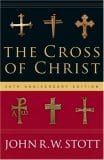The Heart of the Cross


If you follow theology, you know that there have been a number of debates going on the past few years about how to understand Jesus’ death on the cross and its effect on us. This has become a controversial topic, and the controversy is still raging. But it’s not a new debate. Part Two of The Cross of Christ, “The Heart of the Cross,” deals with this issue.
The fourth chapter tackles the problem of forgiveness. Why does forgiveness depend on Christ’s death? Why can’t God simply forgive us? Stott says that to answer this question, we really need to understand the gravity of sin and the majesty of God. He walks us through these and related issues, like human forgiveness and the concept of God’s wrath.
The fifth chapter begins to unpack the concept of substitution, one that is tough for many people to accept. God must forgive sinners in a way that is consistent with his character. There are two complementary aspects of his character that must be satisfied: his love and his holiness. At the cross, God demonstrates both his holiness and love together in equally infinite measure in what some have called a holy love.
The sixth chapter is the most challenging so far. The idea of substitution, and how to understand Christ’s death as our substitute, is controversial and deserves careful treatment. Stott begins by considering Old Testament sacrifices, which prepare us to understand Christ’s sacrificial death. Stott then examines who offered his life as a substitute, arguing that we must understand that it was not Christ alone who died, nor God alone, but God in Christ, “who was truly and fully both God and man and who on that account was uniquely qualified to represent both God and man and to mediate between them.” Understanding this helps us avoid some of the caricatures of substitutionary atonement that we sometimes here today.
There are other aspects of Christ’s death to explore, and that comes next. For Stott, though, substitution is at the center. He writes: “Moved by the perfection of his holy love, God in Christ substituted himself for us sinners. This is the heart of the cross of Christ…Underlying [all other images of the atonement] is the truth that God in Christ has borne our sins and died our death to set us free from sin and death” (pp.165-166).
On a related note, Trevin Wax has an excellent post from yesterday called Don’t Replace the “Substitute”:
I have been asked to review and comment on several of the newer gospel presentations. So far, I have been disheartened to see many abandoning penal substitution altogether. Yes, the atonement is bigger and broader than the penal substitutionary model. But to excise the doctrine completely is to greatly damage the biblical witness…I hope we don’t trade the inadequate presentations from the past with other inadequate presentations.
His whole post is worth reading.
Tomorrow: The Achievement of the Cross.





